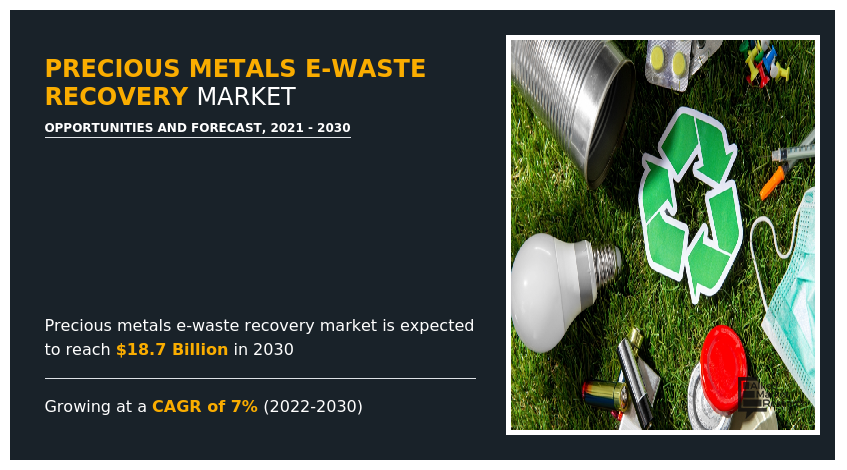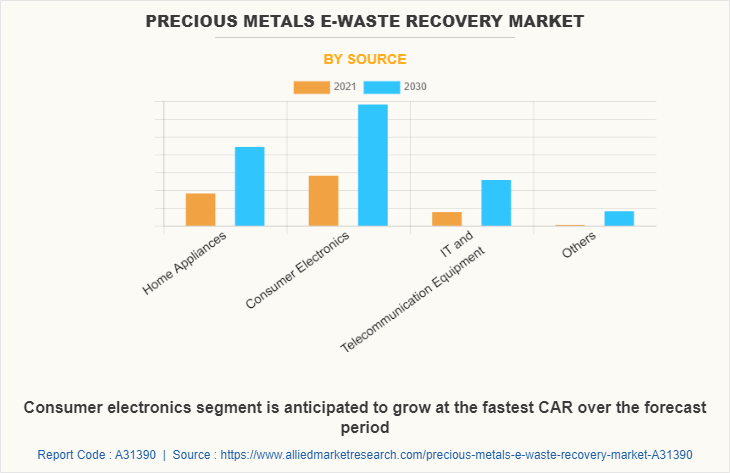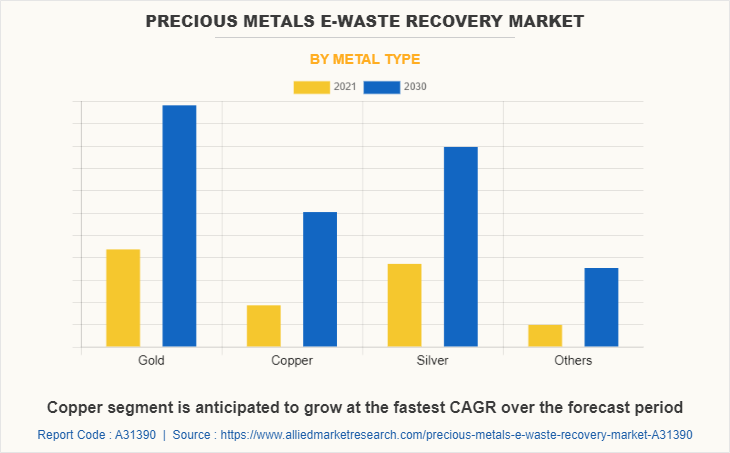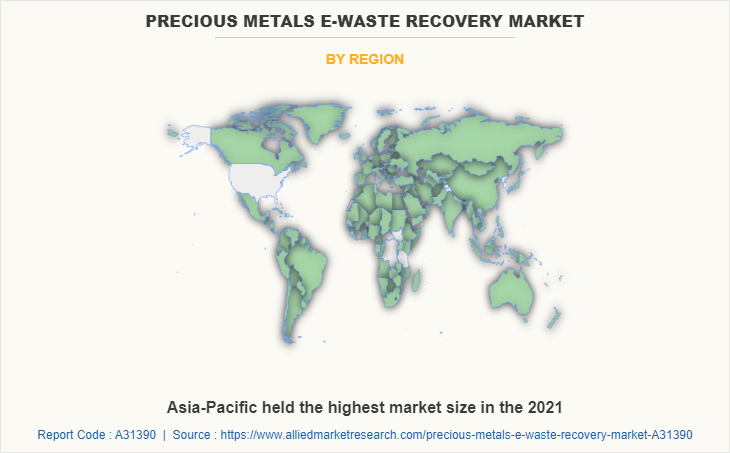Precious Metals E-Waste Recovery Market Research, 2030
The global precious metals e-waste recovery market was valued at $9.4 billion in 2021, and is projected to reach $18.7 billion by 2030, growing at a CAGR of 7% from 2022 to 2030. Precious metals are frequently used in a variety of sectors which are expected to drive the market growth. Due to the conflicts between finite natural resources and rising demand, as well as their economic importance, recycling precious metals from secondary resources is critical. Over the last decade, the quantity of recycled precious metals has been estimated to represent over 30% of worldwide mining production. Over the last decade, there has been an increase in research activity aimed at creating effective recycling systems.

The precious metals e-waste recovery market is segmented into Source and Metal Type.
E-waste electrical and electronic equipment has multiple components, many of which are intrinsically harmful and extremely poisonous in nature, and if not stopped via scientifically sustainable recycling and disposal, can have severe consequences for life, environment, and climate. These factors are expected to restrain the market growth However, haphazard recycling and disposal of e-waste by the unorganized sector without access to adequate technology and resources, can have negative consequences for residents and the environment, including but not limited to the workforce engaged in this trade, groundwater pollution, and so on, particularly due to highly toxic release into the soil, air, and ground water.
Innovative precious metal recovery procedures are a prominent trend that is gaining importance in the precious metal e-waste recovery sector. Companies in the precious metal e-waste recovery industry are working on creative approaches to more efficiently extract precious metals such as gold, palladium, platinum, and others from e-waste. Mint Innovations, a clean tech business established in New Zealand, employs microorganisms and low-cost chemicals to extract valuable metals from e-waste. Some processes that would normally need high temperatures and other harsh circumstances are facilitated by microbes.
The key players profiled in this report include Johnson Matthey, Umicore, Materion Corporation, Boliden Group, Sims Lifecycle Services, Inc., TANAKA Holdings Co., Ltd., Metallix, TES, Heraeus Holding, and Enviroleach Technologies Inc.
The global precious metals e-waste recovery market is segmented on the basis of metal type, source, and region. By metal type, the market is sub-segmented into gold, copper, silver, and others. By source, the market is classified into home appliances, consumer electronics, IT & telecommunication equipment, and others. By region, the market is analyzed across North America, Europe, Asia-Pacific, and LAMEA.

By source, the consumer electronic sub-segment dominated the global precious metals e-waste recovery market share in 2021. Consumer electronics equipment is intended for everyday use and also is mostly used typically in private homes. E-west metal recovery consumer electronics include devices used for computers, televisions, VCRs, stereos, copiers, and fax machines.

By metal type, the gold sub-segment dominated the market in 2021. Gold is utilized in consumer electronics and household appliances to resist corrosion and has great conductivity capabilities, as well as a high economic value, which are factors driving the need for gold recycling from e-waste. These are predicted to be the major factors affecting the precious metals e-waste recovery market size during the forecast period too.

By region, Asia-Pacific dominated the global market in 2021 and is projected to remain the fastest-growing region during the forecast period. Global e-waste creation is now substantially greater than most other waste sources. Although Asia-Pacific nations have launched various projects to achieve ESM for e-waste, their success and efficacy has been hampered by a number of difficulties. Due to a lack of regulations, infrastructure, and financial resources, Asia-Pacific countries are facing tremendous problems such as labor unavailability and rising prices of precious metals. These factors are further predicted to impel the Asia-Pacific market growth in the analysis time.
Impact of COVID-19 on the Global Precious Metals E-Waste Recovery Industry
- The COVID-19 outbreak had a negative influence on the global precious metals e-waste recovery industry due to nationwide lockdowns and in some cases permanent shutdowns of industrial activity and transportation throughout the world to prevent viral propagation. Such factors caused significant disruption in the supply chains of both raw materials and final items.
- China is the leading producer and exporter of electronic consumer goods. However, China being the epicenter of the coronavirus pandemic, its export was affected, leading to a decline in precious e-waste metal recovery production.
- The e-waste is used to extract the precious metals such as gold, silver, and copper. However, the demand for such precious metals was greatly affected owing to decreased in demand, closed borders, and supply chain disruptions due to the outbreak of the COVID-19 pandemic.
- The global economic slowdown has hampered the establishment of new e-waste recycling projects, since the bulk of government money has been shifted to the healthcare sector as a result of the rapid spread of the COVID-19, which has had a significant influence on the market.
Key Benefits For Stakeholders
- This report provides a quantitative analysis of the market segments, current trends, estimations, and dynamics of the precious metals e-waste recovery market forecast from 2022 to 2030 to identify the prevailing precious metals e-waste recovery market opportunities.
- The report elucidates the precious metals e-waste recovery market opportunity along with key drivers, and restraints of the market. It is a compilation of detailed information, inputs from industry participants and industry experts across the value chain, and quantitative and qualitative assessment by industry analysts
- Porter's five forces analysis highlights the potency of buyers and suppliers to enable stakeholders make profit-oriented business decisions and strengthen their supplier-buyer network.
- The report entailing the precious metals e-waste recovery market analysis maps the qualitative sway of various industry factors on market segments as well as geographies
- Major countries in each region are mapped according to their revenue contribution to the global market.
- Market player positioning facilitates benchmarking and provides a clear understanding of the present position of the market players.
- The report includes the analysis of the regional as well as global precious metals e-waste recovery market, key players, market segments, application areas, and market growth strategies.
- The data in this report aims at market dynamics, trends, and developments affecting the precious metals e-waste recovery market growth
Precious Metals E-Waste Recovery Market Report Highlights
| Aspects | Details |
| By Source |
|
| By Metal Type |
|
| By Region |
|
| Key Market Players | Enviroleach Technologies Inc., heraeus holding gmbh, Sims Recycling Ltd., metallix refining inc., umicore, Johnson Matthey plc, TANAKA HOLDINGS Co., Ltd., Boliden Group, Materion Corporation, TES |
Analyst Review
Rapid growth in the IT and communication sectors, particularly in countries such as India and China, is a significant driver of the market growth in the forecast period. Potential health issues in precious metals e-waste recovery market, such as a damaged neurological system and immune system, are expected to impede the market expansion in the forecast years. However, continuous demand for indium from consumer electronics production is expected to drive the market expansion in the next decades. For example, sub-critical water treatment is one of the most successful processes for recovering indium metal from liquid-crystal display panels. The quantity of indium metal recovered from liquid-crystal display trash is proportional to the sub-critical water reaction temperature. This method is effective in extracting indium metal from high-purity liquid-crystal display panels, which is expected to boost the market growth.
Among the analyzed regions, Europe is expected to account for the highest revenue in the market by the end of 2031, followed by Asia-Pacific, North America, and LAMEA. E-Waste garbage, such as computers, refrigerators, and cell phones, has become one of the EU's fastest increasing waste sources. It generated 9 million tons in 2005, but that figure was predicted to rise to more than 12 million tons by 2021.
New technology adoptions in metal extraction create huge investment prospects which is anticipated to boost the precious metals e-waste recovery market in the upcoming years.
Precious metals are required for the fabrication of electrical and electronic components of devices due to their better thermal and electrical characteristics. Furthermore, precious metals such as gold, silver, and platinum are traded as commodities on a worldwide basis. These applications generate a significant demand for precious metals.
Asia-Pacific is the largest regional market for precious metals e-waste recovery market.
The precious metals e-waste recovery market is anticipated to reach $18,645.2 million by 2030.
Johnson Matthey, umicore, Materion Corporation, Boliden Group, Sims Recycling Ltd, TANAKA HOLDINGS Co., Ltd., Metallix, TES, Heraeus Holding, and Enviroleach Technologies Inc. are the major players in the precious metals e-waste recovery market.
Loading Table Of Content...


